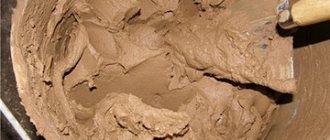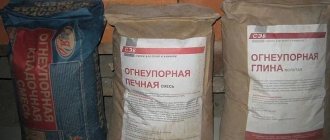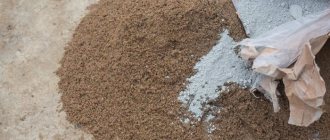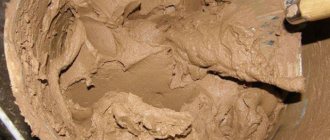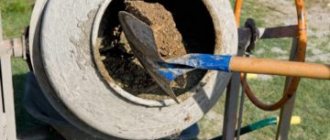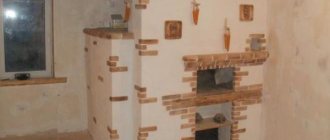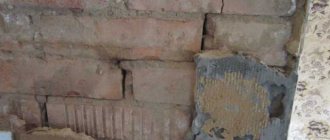Sometimes it is not possible to find a truly professional stove maker. In this matter, it is necessary to take into account many nuances, and any deviation from technical standards can lead to irreparable consequences, which will undoubtedly affect the quality of the structure itself during its operation.
One of the most important points is the selection of masonry mixture. That is why many craftsmen are interested in what composition of mortar with fireclay for laying a stove would be more correct to use. After all, it directly determines whether the structure will be strong and durable.
Ready-made composition for masonry
Special putty is what you need to coat the oven with to prevent it from cracking
You can buy this mixture for eliminating cracks or make it yourself.
Fireproof putty for stoves and fireplaces purchased at a building materials store is ideal for repairs. It perfectly withstands temperatures of 1000 degrees. Before applying it, the stove and cracks should be treated with water. You can do the grouting yourself, following the instructions:
- Pour clay into a container and break up the lumps.
- Fill it with water and leave for 12 hours.
- Pour sand into the clay and knead the mixture.
- Finely chopped straw is added in small portions.
- Add one pack of salt.
Sand and clay are mixed in a ratio of 1:4. For 4 buckets of clay you will need about 50 kilograms of straw.
Methods for removing impurities
From the natural clay stored for oven laying, the first step is to remove foreign impurities. Various methods are used for this.
Dry punching
You can rub the clay through a sieve dry or soaked.
The most primitive way. Use your hands to pick out everything unnecessary - grass, pebbles, garbage, crush large clods. After this, the plastic material must be ground through a metal sieve with cells of approximately 3 mm.
The method can be made a little less labor intensive if the clay is dried. To do this, clay lumps are laid out on a wooden sheet and dried in the sun. In winter, this is done in the cold, laying it under a canopy so as not to be covered with snow. If the volume of material is small, it is placed indoors, on a heated stove or on a heating radiator. The drying speed depends on the size of the lumps: the smaller they are, the faster they dry.
Pour the dried clay into a box with thick walls and crush it with a tamper. After grinding, clay dust is sifted through a sieve with small mesh to remove various inclusions from it: pebbles, splinters, and other debris.
“Dry punching” is a rather labor-intensive task, so it is more advisable to soak the clay for 2-3 days after manual cleaning.
- Place the material in a large basin in layers of 12–15 cm, with plenty of wetting.
- Pour water in an approximate ratio of one to four with clay.
- When the mass softens, mix with a concrete mixer or other means.
- Wipe through a grid with 2–2.5 mm mesh.
The bottom layer - sand and stones - is not suitable for holding bricks together
There is also a more ancient method of excruciation:
- Several holes are drilled vertically in a wooden container with a small distance between them.
- Each of them, before filling the tub with liquid clay mass, is plugged with a wooden stopper.
- Grains of sand and various small stones precipitate first due to their greater weight.
- Subsequently, after settling, clay particles settle to the bottom.
- The top layer of water gradually becomes lighter, but you need to wait until the liquid becomes transparent. As soon as the boundary of the clarified moisture drops slightly below the first hole from above, the plug is removed. The settled water flows out of the container.
- After the next level of settled liquid appears, pull out the next plug.
This process is repeated until all clarified water is completely drained. To speed up the precipitation, after loading the solution into the tub, you will need to add bitter Epsom salt - approximately one pinch per bucket. If you don’t have a wooden barrel at hand, it can be successfully replaced by a metal container of suitable height and volume. The principle of operation is the same with one difference - first short pieces of tubes are soldered into the holes, and plugs are installed in them.
When all the settled liquid has been drained, the liquid clay is transferred to a wide box and left in the sun to evaporate excess moisture. After the dried material ceases to be fluid, stir it periodically with a shovel. As soon as the mass becomes similar in texture to thick dough and stops sticking to the palms, it is covered with polyethylene or oilcloth and stored until baking begins.
Production of material
It is important to store the dry fireclay clay mixture in a dry place
To make a solution of fireclay clay for laying out a stove with your own hands, you need to follow certain instructions and use the main components in certain proportions.
Fireclay powder has the properties that it acquired depending on the production method. The fraction of the material also matters. Fireclay clay has its own special marking. If the letter “U” is indicated on the packaging, this indicates the use of defective kaolin in production. It is cheaper, but you should not use it in important work. Options for diluting fireclay clay:
- 2 parts of fireclay sand with a fraction of no more than 0.5 mm to 1 part of kaolin;
- 4 parts fireclay sand to 1 part kaolin and the same amount of blue clay.
For the durability of the treated surface, the solution with clay must be mixed correctly
Ordinary sand should not be used when preparing such a solution. When heated, it will expand greatly. River water should also not be used, as it will not provide the necessary adhesion. If the solution needs to be more durable, Portland cement is added to it. But this ingredient will reduce the fire resistance characteristics. If you take into account all these features, working with this material will be easy and simple.
It is important to keep the solution and not rush to add water to it. Patience is key here, otherwise the clay will crack.
There are special compositions for quick mixing. They are convenient because you don’t have to wait for several days. True, they cost more. PVA glue is added to this mixture. Fiberglass is used for reinforcement.
Mineral composition
The raw material for the production of fireclay is clay, consisting of highly dispersed hydroaluminosilicates. In addition to them, the dry mass contains a certain amount of impurities. The extracted raw materials undergo a roasting procedure, after which they are enriched with minerals. There are many recipes that differ in the amount of water, fireclay powder and additives. The duration of heat treatment also varies. It depends on what characteristics the output product should have . The main difference is the colors and types of texture.
Chemical elements in refractory clay:
- Fe2O3;
- K2O;
- Al2O3;
- Si02;
- Na2O;
- CaO;
- MgO.
Advantages and disadvantages
This material does not cause controversy both among professional builders and among those who like to do household work with their own hands, since it is practically indispensable in the manufacture of stoves and various fireboxes. Fireclay clay does not have any obvious disadvantages, but this does not exclude its negative properties. The advantages of the material include:
- Excellent heat resistance;
- Reliability and long-term durability during professional masonry;
- Environmental friendliness of the material;
- The presence of micropores for the passage of steam, which also prevents the expansion of the masonry and its destruction;
- High level of adhesion.
There are fewer disadvantages, and besides, they are typical for many high-quality materials:
- High cost, since the production of such clay is technologically more complex and dangerous than the production of ordinary building clay;
- Fireclay dust enters the respiratory tract, so it is necessary to use a respirator when working.
Where is it used?
Understanding what fireclay clay is, it is easy to determine the scope of use of raw materials. The powder in solutions is used to create fire-resistant building materials. The substance is used to make strong bricks or clinker tiles. The finish has a high price, so professionals recommend combining it with conventional models.
Using fireclay mortar Source techno-comf.ru
Checking the properties of the main ingredient of the refractory mixture
There are several proven methods for checking the quality of clay:
Determining the readiness of the solution.
- Take about 1 kg of dry clay (0.5 l) and pour water into it portionwise, mixing it with your hands. The clay should completely absorb water and be a solution with a thick consistency. The next step is to roll balls with a diameter of 4-5 cm. A flat cake with a diameter of 9-10 cm is made from the resulting ball. All this is dried naturally for 3-4 days. Next, inspect for surface cracks. Identification of cracks on the ball and cake indicates increased fat content of the material. If no cracks are found on the ball and cake, then it is necessary to drop the ball from a height of no more than 1 m. The preservation of the integrity of the ball after the fall indicates the quality of the clay, and destruction shows that the clay is thin.
- Take approximately 3.6-5.4 kg of clay (2-3 l) and pour it into a container, thoroughly mixing with a wooden spatula and kneading the lumps. If the clay sticks to the shovel quite well, it means it has a high fat content. You need to add a little sand to this solution. If the clay remains partially on the blade, then such material is considered high quality and suitable for use. Poor adhesion of the mixture indicates that the mixture is lean and requires the addition of fatty clay.
- Take up to 1 kg of dry clay (about 0.5 l) and prepare a thick solution, mixing thoroughly with your hands. Balls with a diameter of 4-5 cm are prepared from the resulting composition. Next, take two smooth plates of chipboard or wood, place the ball on one of them, cover with the other and squeeze until cracks appear on the ball. Test control:
- if the ball collapses at the slightest pressure, it means the clay is thin;
- if cracks appear when squeezing up to 1/4-1/5 of the diameter of the ball, then the clay has a low fat content;
- if cracks appear when compressed to 0.3 of the ball diameter, then the mixture is normal and suitable for further use;
- Oily clay cracks when compressed to 0.5 times the diameter of the ball.
- A ball is made from the resulting steep solution and rolled out until sausages with a diameter of 1-1.5 cm and a length of 160-200 mm are formed. Next, they are stretched until they break. A sample made of lean clay practically does not stretch and gives a rather uneven break. Normal clay is characterized by smooth stretching and breaks when thinned to 20% of the original sample. Oily clay, on the contrary, stretches out gradually and gives a smooth break with the formation of sharp ends at the point of break.
Technical specifications
When purchasing fireclay clay, you need to pay attention to the shelf life of the material. It is also important that the seller stores it in suitable conditions. Deteriorate the properties of the material:
- wet air;
- long-term storage;
- water access.
The shelf life of the material is 3 years if it is stored in a dry place and the integrity of the original packaging has not been compromised. What parameters should high-quality clay have:
- inclusion sizes are around 2 mm;
- moisture absorption rates - from 2 to 10% for high-burnt, and up to 20% for low-burnt;
- humidity - no more than 5%;
- fireproof rating - up to 1850 degrees.
The main advantages of clay with refractory properties include its ability to withstand high temperatures. It also has good adhesion characteristics and vapor permeability. Other advantages include:
- long service life;
- environmental friendliness;
- reliability.
The downside is the high cost when compared with similar types of clays.
Making your own mixture - all options
Having understood the principle of determining the plasticity of a masonry mortar, you can begin mixing it. This operation can be done with your own hands using different methods. A very simple technique that we, in fact, have already considered. You need to soak the clay in a small volume of water 24 hours before the planned procedure for laying the stove. Then (a day later) add liquid to the soaked material and mix the composition with a shovel until it becomes creamy. After this, you need to strain the resulting mixture and add sand to it (remember the proportions indicated above).
Mortar on brick
In cases where impeccably clean clay is used (without foreign inclusions and small stones), the mixture for stoves can be prepared with your own hands using the second method. Its essence is this. Add fine sifted sand to clean clay and fill the resulting composition with water (a quarter of the total volume of the mixture). Mix the mixture thoroughly until it reaches a creamy consistency. At the exit, it should slide off the shovel without difficulty, but under no circumstances should it spread. The next step is to add cement and salt to the resulting composition. These components will increase the strength characteristics of the clay mortar for the oven. For 10 liters of mixture take 750 mg of cement, about 200 g of salt.
The third method involves the use of fireclay and chamotte sand. These components should be mixed with each other in the same ratio. Then add water to the mixture. Its amount is 25% of the volume of clay. Mix the composition. That's all. This is perhaps the most basic way to prepare mortar for laying stoves. There is another method for preparing the mixture we are interested in with your own hands. It is made from loam. You will have to mix 10 small portions of different solutions. The first mixture has proportions - part cement + part sand + 10 parts loam, the second - 2 hours sand + 1 hour cement + 9 hours clay and so on. The latter composition will thus contain 1 hour of cement, 10 hours of sand and 1 hour of loam.
All mixed solutions should be placed in small boxes and left until completely dry in the fresh air (6-7 days). After a week, you begin to inspect the resulting mixtures. For masonry, choose the composition that contains the maximum amount of clay and completely eliminates the phenomenon of cracking. Believe me, it will be ideal - it will be able to withstand oven heating temperatures of up to 500–600 °C without deformation or crumbling. Choose your own option for preparing clay mortar!
Possible problems
Fireclay composition for masonry has practically no negative reviews from builders; it is difficult to imagine a more reliable solution for stoves. This material is very durable, lasts a long time, without compromising reliability. It is environmentally friendly, safe and does not deteriorate from external influences of temperature and moisture. Adhesion is at the highest level.
However, all these advantages do not exclude the presence of some disadvantages that are worth considering:
- the cost of fireclay composition is quite high, the production of this material is associated with technical difficulties;
- the dust of the composition is very fine and can damage the respiratory system if protective equipment is not used;
- the solution cannot be stored for a long time, you need to carefully calculate how much of the composition you need on a particular day;
- the required consistency can be difficult to achieve even for a professional: after three days of swelling, the composition may turn out to be completely different from what is needed, this is influenced by the level of humidity and temperature;
- To achieve the ideal consistency of thickened sour cream without lumps, you need to take your time, add water in small portions, control the amount of components and the resulting composition so that it does not go to waste and is of really high quality.
How to dilute and what to mix fireclay clay with - step-by-step diagram
Step 1: Infuse the powder in water
To prepare a mortar from fireclay clay for plaster, we need a pack of fireclay powder. Pour the powder into the container, gradually adding water until the powder is completely covered with water. Before diluting the final solution, the fireclay clay must sit for at least three days.
Step 2: Making the final batch
After we have waited the required time, we will stir the resulting mixture again, adding a little quartz sand and water if necessary. If the solution turns out to be liquid, you can sprinkle in more powder; if it is too thick, dilute with additional water. The consistency of the ready-to-use solution should resemble sour cream - with such a thickness it will not drain from the surface and will stick well to the wall.
Of course, you can also purchase a composition for instant mixing - it does not require steeping for three days, but it also costs more. In any case, PVA construction adhesive should be added to the resulting composition; it would not hurt to reinforce such a solution with crushed fiberglass. Plastering with this solution does not require any special skills - just prepare large and small spatulas in advance and apply the solution evenly to the surface.
Step 3: Prepare the surface
Based on the reduced plastic properties of fireclay, it is imperative that the surface you want to plaster be provided with a mesh, and to improve adhesion, it must be treated with a good primer. Since we are most often talking about plastering stoves and fireplaces, the primer should be heat-resistant and the mesh should be metal. In this case, you will compensate for the plasticity of fireclay and achieve the highest fire resistance of the plaster.
The difference between chamotte and ordinary ceramic bricks
Fireclay brick cannot be confused with any other block, even with other refractories. Mostly yellow or even light yellow in color, with a whitish tint. The main difference between fireclay bricks is the high content of aluminum oxide in various chemical forms and modifications.
In comparison with ceramic bricks, with a high content of iron oxide and silicon oxide, fireclay bricks have their own characteristics that affect their durability:
- The surface of the block is highly porous, but these pores are very small; the solution penetrates poorly into them, but moisture and air penetrate well;
- The coefficient of thermal expansion of each brick is strictly individual, which will require difficult and painstaking selection of the composition of the mortar for masonry;
- The refractoriness and ductility of fireclay bricks largely depends on the operating mode of the furnace, and not on the composition of the mortar or the method of laying.
Advice! For lining one furnace, you cannot use fireclay from different batches or a set of randomly selected bricks; in extreme cases, different types can be converted into broken or fireclay powder.
What is included in the process of preparing the solution?
The process of preparing the solution occurs according to the following algorithm:
- Dry clay is poured into a pre-prepared trough.
- If the clay can be classified as a fatty type, add river sand at the rate of 1 part clay to 2 parts sand.
- Then add water at the rate of 1 part water to 4 parts clay solution.
Determination of the plasticity of clay mortar.
The masonry mortar is ready. You can check it in a simple way: by making a round ball of small volume from the solution and throwing it with force on a hard surface. The ball will collapse if there is excess sand, if not, the solution is normal. You can also determine the quality of the clay before preparing the mixture. Taking half a liter of clay, mix it, gradually adding water, mix by hand until the clay solution sticks to your hands. At the end of the manipulations, roll a ball with a diameter of 40-50 mm, place it and let it dry for three days.
If there are cracks, it is necessary to add river sand to the mixture, after sifting it on a special sieve. If the ball is not damaged and does not collapse when dropped from a height of 1 meter, then the clay composition is suitable for construction.
The following method of testing clay is one of the most optimal. You need to beat 0.5 liters of clay by hand, like dough. From the specified mixture, prepare a spherical object with a diameter of 50 mm and, placing it between two parallel wooden planks and applying mechanical force, deform the ball until it cracks. Let's look at the result:
- the presence of skinny clay - the ball disintegrated;
- average presence of fatty parts in clay - deformation of 1/5 of the ball;
- normal clay - cracks when compressing 13 balls;
- greasy - the appearance of small cracks when deformed by half.
Installation procedure
The beginning of the masonry process should be careful marking. An excellent help will be the so-called dry laying, when they select bricks, adjust them to each other and set the size of the gap between the bricks. Upon completion of dry laying, the bricks are removed in the order they appear in the test laying. Do not forget that the seam should be covered with the top brick, which will provide greater reliability to the masonry
Particular attention should be paid to the quality of the seams to avoid problems after completion of the work.
The quality of the solution preparation directly affects the thickness of the seam of the refractory masonry. Accordingly, seams according to this indicator are divided into four groups:
- Category 1 - seam thickness less than 1 mm;
- Category 2 - the seam is 2 mm;
- Category 3 - the seam is 3 mm;
- Category 4 - seam thicker than 3 mm.
The category of masonry is determined by the temperature conditions for using the masonry. The higher the planned temperature, the thinner the seam should be, and the more thoroughly the solution is mixed. Means for checking the quality of refractory brick masonry. The first step is to control the seam category. To do this, use a special probe with a width of 15 mm and a thickness equal to the thickness of the seam. Such a probe should not penetrate the seam to a depth of more than 20 mm.
No masonry is complete without tapping each brick with the handle of a trowel. This ultimately leads to uneven masonry. The defect must be corrected while the solution is fresh enough. To ensure even horizontal laying and equal width of seams, order strips are used. A thin, durable cord is attached to them, which sets the correct styling parameters.
Each subsequent layer is placed along a cord stretched on nails inserted into a fresh seam. At each stage of the process, you should carefully monitor the uniform distribution of the mortar between the bricks. Uneven distribution significantly degrades the performance of refractory masonry. As with conventional masonry, the brick should be moistened generously. Otherwise, the brick will actively suck water from the mortar, thereby significantly worsening its characteristics.
The best result will be if the bricks are kept in a container of water for some time before laying. This procedure will clean the material from dust and saturate it with water. Laying refractory bricks using properly prepared mortar is not an easy process, but if everything is done according to the rules, your stove or fireplace will delight the eye with beauty and the body with beneficial warmth for many years.
How to dilute clay to putty a stove
Despite the sea of modern technologies for laying stoves, fireplaces, fireplace complexes and all kinds of heating and decorative innovations, stoves are still laid using clay mortar. They also use it to repair, plaster, and correct defects in masonry. Ready-made clay stove mixtures have appeared in building materials stores. Unfortunately, it is only suitable for working with fireclay bricks, where ordinary clay will not work. In other cases, to prepare a masonry or coating mixture, you will have to look for clay yourself.
How to make a clay mixture
It is necessary to distinguish between the process of plastering a stove for whitewashing and the process of sealing cracks in masonry joints. Accordingly, the solution will require different thicknesses and compositions. The ideal clay for coating and repair is the same clay from which bricks are made. Unfortunately, they stopped making bricks on their own long ago, preferring to buy them, and therefore it’s impossible to find a “deposit” for them.
You should choose low-fat red clay, and if necessary, additionally deplete it with sand. The mixture for sealing cracks in seams is prepared as follows:
- We take a clay-sand mixture and experimentally determine the required proportions of the components. To do this, prepare a plasticine-like solution and roll small balls from it (no more than 2 mm in diameter).
- We stretch our hand with the clay ball forward and drop it on the floor. If the ball does not crack or smear with a blot, then this is an ideal mixture for repairing stove seams.
- Add finely chopped straw for reinforcement and 1 kg of salt per bucket of the mixture. You can start working.
The solution for plastering the stove is prepared in a similar way, only its consistency is creamy.
How to coat a stove
When starting repairs, you should warm up the stove a little before work. The procedure for sealing cracks in the furnace is as follows:
- remove all the crumbling layer and all the lime whitewash (clay will not fall on it);
- spray or wet the repair areas with a brush so that the dry areas bond better with the repair solution and do not draw moisture from it;
- seal the seams tightly with a plasticine-like mixture, and plaster the surface with a liquid solution.
You can coat the oven by hand or use a spatula and trowel.
After the solution has dried, additionally coat small cracks. Date: September 25, 2022
Useful video
Drying the stove is accompanied by ignition of the fuel. You will have to deal with this process every time, so prepare in advance for the specific features of your design. It is known that two identically built stoves can melt differently.
Before you force dry the device, you need to make sure that there is draft in the chimney. To do this, a tourniquet is made from newspaper and set on fire. The flame should deflect towards the pipe. With this maneuver we also achieve heating of the air in the pipe, so use this method every time you light the stove.
There are certain restrictions on how to dry the stove, for example, in bad weather it is better to abandon this idea. The total time for one cycle should be about 3 hours. By drying, you have not protected the device from mechanical damage.
Cracks in the masonry can also form if the structure is not treated carefully enough. The firewood must be stacked carefully to avoid hitting the walls of the firebox. Remember safety at any stage of using the oven.
Video showing another way to determine the best consistency of clay mortar and mix it.


